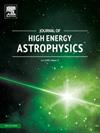Diagnostics of dark energy evolution using logarithmic Om(z) parameterization
IF 10.5
4区 物理与天体物理
Q1 ASTRONOMY & ASTROPHYSICS
引用次数: 0
Abstract
In this study, we explore the logarithmic parameterization as a tool for diagnosing the nature and evolution of dark energy. We propose the form , where α and β are free parameters, and analyze its behavior for different values of α. When , the model reduces to a constant, consistent with the cosmological constant, while indicates dynamical dark energy, with suggesting phantom-like behavior and indicating quintessence-like dynamics. By constraining the model parameters using observational datasets such as OHD, the Pantheon+ sample, and the combined dataset (OHD+SNe+BAO), we obtain tight constraints on the cosmic evolution. Our results suggest a mild deviation from the standard ΛCDM model, with a slight preference for phantom-like behavior at low redshifts. The deceleration parameter and equation of state parameter were analyzed to understand the cosmic transition from deceleration to acceleration, with a transition redshift around . The present-day deceleration parameter was found to range from to , and the EoS parameter values varied between and . The inferred Hubble constant values exhibit dataset-dependent variations, highlighting the persistent Hubble tension. Our analysis suggests that the logarithmic parameterization offers a flexible framework for studying cosmic acceleration.
利用对数Om(z)参数化诊断暗能量演化
在这项研究中,我们探索了对数 Om(z)参数化,以此作为诊断暗能量性质和演化的工具。我们提出了Om(z)=αln(1+z)+β的形式,其中α和β是自由参数,并分析了不同α值下的行为。当α=0时,模型简化为一个常数,与宇宙学常数一致,而α≠0表示动态暗能量,α>0表示类似幽灵的行为,α<0表示类似五元素的动态。通过使用 OHD、Pantheon+ 样本和组合数据集(OHD+SNe+BAO)等观测数据集来约束模型参数,我们获得了对宇宙演化的严格约束。我们的结果表明与标准ΛCDM模型有轻微偏差,在低红移时略微偏向于幻影行为。我们对减速参数和状态方程参数进行了分析,以了解宇宙从减速到加速的过渡,过渡红移约为ztr≈0.6-0.8。发现当今的减速参数范围在 q0=-0.55 到 q0=-0.60 之间,而 EoS 参数值在 ω0=-0.70 和 ω0=-0.73 之间变化。推断出的哈勃常数值随数据集的变化而变化,凸显了持续存在的哈勃张力。我们的分析表明,对数 Om(z) 参数化为研究宇宙加速提供了一个灵活的框架。
本文章由计算机程序翻译,如有差异,请以英文原文为准。
求助全文
约1分钟内获得全文
求助全文
来源期刊

Journal of High Energy Astrophysics
Earth and Planetary Sciences-Space and Planetary Science
CiteScore
9.70
自引率
5.30%
发文量
38
审稿时长
65 days
期刊介绍:
The journal welcomes manuscripts on theoretical models, simulations, and observations of highly energetic astrophysical objects both in our Galaxy and beyond. Among those, black holes at all scales, neutron stars, pulsars and their nebula, binaries, novae and supernovae, their remnants, active galaxies, and clusters are just a few examples. The journal will consider research across the whole electromagnetic spectrum, as well as research using various messengers, such as gravitational waves or neutrinos. Effects of high-energy phenomena on cosmology and star-formation, results from dedicated surveys expanding the knowledge of extreme environments, and astrophysical implications of dark matter are also welcomed topics.
 求助内容:
求助内容: 应助结果提醒方式:
应助结果提醒方式:


